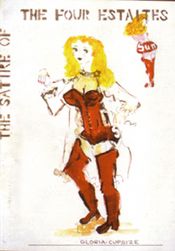A Satire of the Three Estates facts for kids
Quick facts for kids A Satire of the Three Estates |
|
|---|---|

Detail from the front cover of the programme for John McGrath's 1996 adaptation.
|
|
| Written by | David Lyndsay |
| Date of premiere | 1540 (private) / 1552 (public) |
| Place of premiere | Edinburgh, Scotland |
| Original language | Lowland Scots |
| Genre | Morality play |
A Satire of the Three Estates (its old name was Ane Pleasant Satyre of the Thrie Estaitis) is a famous play from Scotland. It was written a long time ago in a language called Middle Scots, which is an older form of the Scots language. This play is a special kind of story called a morality play. It uses characters to teach lessons about right and wrong. It's also a satirical play, meaning it uses humor and exaggeration to make fun of things. The play criticizes the main groups of people in Scottish society at the time.
Contents
What is A Satire of the Three Estates?
This play is a mix of comedy and serious lessons. It uses funny situations and characters to point out problems in society. The main goal of the play was to show how different groups of people were not doing their jobs well. It especially focused on the leaders of the church and the rich nobles.
Who Wrote This Play?
The play was written by a Scottish poet and writer named Sir David Lyndsay. He was known as a "makar," which is an old Scottish word for a poet. Sir David Lyndsay was an important figure in the court of King James V of Scotland. He used his writing to comment on the world around him.
When and Where Was It First Performed?
The play was first performed in a private setting in 1540. This might have been in the hall of Linlithgow Palace. The full, complete version of the play was first shown to the public in 1552. This big outdoor performance happened in June in a town called Cupar, in Fife, Scotland. The action of the play took place near Castle Hill. It was later performed again in Edinburgh in 1554, also outdoors. The full text of the play was finally printed in 1602.
What Are the Three Estates?
The title of the play, A Satire of the Three Estates, refers to the three main groups of people who were part of the Parliament of Scotland at that time. These groups were:
- Spiritualitie: This represented the clergy, or church leaders.
- Temporalitie: This represented the lords and nobles, who held power and land.
- Merchant: This represented the burgh representatives, who were people from towns and cities, often involved in trade.
The play strongly criticizes these groups, especially the church leaders. It shows the tensions and problems in Scottish society during a very important time in Scottish history. This was a period when many big changes were happening, especially in religion.
Why Was This Play Important?
A Satire of the Three Estates was very important because it spoke directly to the people. It used humor and familiar characters to highlight serious issues like corruption and unfairness. It showed how people felt about their leaders and the way society was organized. The play helped people think about what was right and wrong in their country. It also gives us a great look into what life was like in 16th-century Scotland.
Images for kids
-
The 1540 interlude was performed in the hall of Linlithgow Palace
See also



